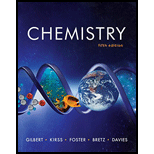
Concept explainers
Interpretation: The explanation corresponding to if the given compounds can be distinguished by using their dipole moments or not is to be determined.
Concept introduction: The dipole moment is the quantitative measure of charge of the molecule.
To determine: If the given compounds can be distinguished by using dipole moments or not.
Answer to Problem 9.1VP
Solution
The given compounds can be distinguished by using their dipole moments.
Explanation of Solution
Explanation
Given
The structures of two isomers of
The dipole moment of the molecule is the sum of individual dipole moments coming from all the bonds present in the molecule. The change in orientation of the atoms in the molecule changes the measure of charge accommodate by the individual bond which results in the different dipole moments of the molecule. Since, the given isomers have direction of bonds and measure of charge different on the two isomers. Therefore, they can be distinguished by using its dipole moments.
Conclusion
The given compounds can be distinguished by using their dipole moments.
Want to see more full solutions like this?
Chapter 9 Solutions
Chemistry: The Science in Context (Fifth Edition)
 ChemistryChemistryISBN:9781305957404Author:Steven S. Zumdahl, Susan A. Zumdahl, Donald J. DeCostePublisher:Cengage Learning
ChemistryChemistryISBN:9781305957404Author:Steven S. Zumdahl, Susan A. Zumdahl, Donald J. DeCostePublisher:Cengage Learning ChemistryChemistryISBN:9781259911156Author:Raymond Chang Dr., Jason Overby ProfessorPublisher:McGraw-Hill Education
ChemistryChemistryISBN:9781259911156Author:Raymond Chang Dr., Jason Overby ProfessorPublisher:McGraw-Hill Education Principles of Instrumental AnalysisChemistryISBN:9781305577213Author:Douglas A. Skoog, F. James Holler, Stanley R. CrouchPublisher:Cengage Learning
Principles of Instrumental AnalysisChemistryISBN:9781305577213Author:Douglas A. Skoog, F. James Holler, Stanley R. CrouchPublisher:Cengage Learning Organic ChemistryChemistryISBN:9780078021558Author:Janice Gorzynski Smith Dr.Publisher:McGraw-Hill Education
Organic ChemistryChemistryISBN:9780078021558Author:Janice Gorzynski Smith Dr.Publisher:McGraw-Hill Education Chemistry: Principles and ReactionsChemistryISBN:9781305079373Author:William L. Masterton, Cecile N. HurleyPublisher:Cengage Learning
Chemistry: Principles and ReactionsChemistryISBN:9781305079373Author:William L. Masterton, Cecile N. HurleyPublisher:Cengage Learning Elementary Principles of Chemical Processes, Bind...ChemistryISBN:9781118431221Author:Richard M. Felder, Ronald W. Rousseau, Lisa G. BullardPublisher:WILEY
Elementary Principles of Chemical Processes, Bind...ChemistryISBN:9781118431221Author:Richard M. Felder, Ronald W. Rousseau, Lisa G. BullardPublisher:WILEY





